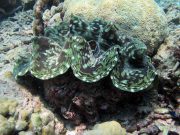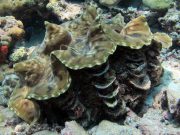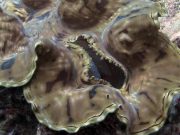Diving with Giant Clams
Lanta Marine Life | Tridacnidae
The giant clams are members of the Tridacninae family of large saltwater clams. The two-part shell usually has a wavy opening that never properly closes and faces the sunlight. They are a common sight during our Koh Lanta dive trips
The hinged side of the shell is at the bottom, attached to a hard surface by a large mass of tough silky filaments that grow from the gap between the valves near the hinge. Some giant clams burrow into coral, with most of the shell hidden and only the shell opening facing sunlight.
The giant clams live in the shallow waters of coral reefs and live in symbiosis with single-cell photosynthetic algae (zooxanthellae) much the same as a coral polyp. The zooxanthellae live within the clam, producing food through photosynthesis which it shares with the clam.
The clam faces the shell opening and body to the sunlight in order to maximise the productivity of its algae 'farm'. Although giant clams are highly dependent on the symbiotic algae, they are still able to filter feed like other bivalves.
3 species found on this page:
Fluted Giant Clam
(Tridacna squamosa)
The Fluted Giant Clam is a medium to large clam, and is easily identified by the rows of leaf-like fluted edges on its shell called 'scutes'. Whilst not always easy to see small details, the scutes provide shelter for small invertebrates such as shrimp, crabs and other small clams.

Fluted Giant Clams @ Koh Bida
The mantle colour varies from greenish brown to yellowish tan to greenish blue or purple, with wavy lines, spots and blotches. There are two openings in the mantle to allow water to pass through, feeding and light to reach the zooxanthellae. It’s not uncommon to find crabs, small fish, shrimp and other animals living within the clam.
This giant clam grows to 40 cm in length and is often found in the open, or close to coral rubble areas, mostly in shallow water areas.
Giant Clam
(Tridacna gigas)

Giant Clam @ Koh Haa
The Giant Clam is the largest bivalve in the world. The shell is typically smooth, however other marine organisms attach themselves to the shell, which in the wild can then appear quite rough.
The shell has four vertical folds which create the ’wavy’ appearance of the mantle, which varies in colour from brown to tan to green through blue to purple. The mantle is fused except for two siphon holes, the longer hole to draw in water, and the smaller hole to expel water. The gills can be seen through the longer hole, and the shell is open during the day to allow sunlight to reach the zooxanthellae.
The Giant Clam grows to 130 cm and is usually found in flat shallow areas with plenty of sunlight. This is a slow growing species which is critically endangered in some areas due to over harvesting for food and shells.
Boring Giant Clam
(Tridacna crocea)
The Boring Giant Clam burrows deep into cracks in the reef and is usually only seen from the top, with only the mantle exposed.
The mantle colour varies from yellow to gold to tan to brown to green to blue to purple.

Boring Giant Clam @ Koh Bida
A row of ‘eyes’ can be seen along the margin of the mantle, and these provide rudimentary ‘vision’ allowing the clam to detect light, dark, and shadows from possible predators.
The clam chooses a location which is exposed to sunlight and attaches itself to the hard coral skeleton using strong silky threads (basal threads) from the hinge of the two shells (valves).

Boring Giant Clam @ Koh Haa
This clam is the smallest of all the giant clams, growing to 15 cm across and may form dense colonies of individuals.
Diving with Giant Clams around Koh Lanta
Scuba Diving & Snorkel Trips
If you'd love a chance to spot Giant Clams on one of our daily high season diving trips from Koh Lanta then send us an email to info@diveandrelax.com.
Join our high season speedboat dive trips to some of Thailand's best dive sites and enjoy small groups, short journey times, with a focus on great personal service, safety and fun.
Not yet a certified diver? Learn to Scuba Dive on Koh Lanta with the 3 day SSI Open Water Diver course.
Book online to save 10% on dive trips and scuba courses on Koh Lanta.
Find Out More
Indo-Pacific Marine Life Guides
- Allen, G., Steene, R., Humann, P., DeLoach, N. (2003) Reef Fish Identification, Tropical Pacific. Jacksonville, FL., USA: New World Publications, Inc., ISBN 1-878348-36-1.
- Humann, P., DeLoach, N., (2010) Reef Creature Identification, Tropical Pacific. Jacksonville, FL., USA: New World Publications Inc., ISBN 978-1-878348-44-9
- Debelius, H. (2013) Indian Ocean Reef Guide. Frankfurt, Germany: IKAN - Unterwasserarchiv, ISBN 978-3-939767-52-7.
- Debelius, H. (2004) Nudibranchs and Sea Snails, Indo-Pacific Field Guide. Frankfurt, Germany: IKAN - Unterwasserarchiv, ISBN 3-925919-51-1
- Erhardt, H., Knop, D. (2015) Corals Indo-Pacific Field Guide. Frankfurt, Germany: IKAN - Unterwasserarchiv, ISBN 3-925919-69-4.
- Veron J.E.N., Stafford-Smith M.G., Turak E. and DeVantier L.M. (2016). Corals of the World


